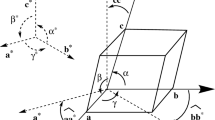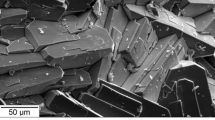Abstract
Available systems of empirical (crystallographic) ionic radii are compared. All these systems turn out to be compatible if the O2− radius is taken to be 0.140 nm. The choice of the oxygen ionic radius is dictated by the equality of the metal ion-oxygen ion distances in oxide crystals and the metal ion-oxygen atom distances in crystal hydrates and concentrated aqueous solutions. In all systems of empirical ionic radii under consideration, the uncertainty of determination of ionic radii is 0.002–0.005 nm. A new method of determination of the ionic radii of elements in unusual valence states is suggested: from the empirical dependence of the electron density at an atom in a given valence state on the atomic radius, a two-parameter equation relating the ionic radii of Period 4–7 elements in two valence states is derived, which allows one to calculate the ionic radius that cannot be determined by crystallography because of the lack of stable compounds in this valence state. Ionic radii are calculated for all Period 4–7 elements in all valence states. They constitute a nearly complete system of ionic radii. There is a linear relationship between the atomic nucleus charge and the inverse ionic radius. It is shown that the square root of the ionization potential is a linear function of the inverse ionic radius. The as yet experimentally unknown ionization potentials of 78 ions of different elements are estimated.
Similar content being viewed by others
References
Sollas, A.A., Ionno-atomnye radiusy i ikh znachenie dlya geokhimii i khimii (Ionic and Atomic Radii and Their Significance for Geochemistry and Chemistry), Leningrad, 1969, p. 33.
Bragg, W.L., Philos. Mag., 1920, vol. 40, p. 169.
Lande, F., Z. Phys., 1920, vol. 1, p. 191.
Wasastjerna, J., Soc. Sci. Fenn. Comm. Phys.-Math., 1923, vol. 38, p. 22.
Goldschmidt, V.M., Trans. Faraday Soc., 1929, vol. 25, p. 255.
Pauling, L., J. Am. Chem. Soc., 1927, vol. 49, p. 765.
Pauling, L., The Nature of the Chemical Bond, Ithaca: Cornell Univ. Press, 1939. Translated under the titles Priroda khimicheskoi svyazi, Moscow, 1947.
Zachariasen, W.H., Acta Crystallogr., 1952, vol. 5, p. 660.
Bokii, G.B., Kristallokhimiya (Crystal Chemistry), Moscow, 1971.
Lebedev, V.I., Ionno-atomnye radiusy i ikh znachenie dlya geokhimii i khimii (Ionic and Atomic Radii and Their Significance for Geochemistry and Chemistry), Leningrad, 1969.
Batsanov, S.S., Zh. Strukt. Khim., 1962, vol. 3, p. 616.
Batsanov, S.S., Dokl. Akad. Nauk SSSR, 1978, vol. 238, p. 95.
Shannon, R.D. and Prewitt, C.T., Acta Crystallogr., Sect. B: Struct. Sci., 1969, vol. 25, p. 1427; 1970, vol. 26, p. 1046.
Shannon, R.D., Acta Crystallogr., Sect. A: Found. Crystallogr., 1976, vol. 32, p. 751.
Zefirov, Yu.V. and Zorkii, P.M., Usp. Khim., 1989, vol. 58, p. 713.
Zefirov, Yu.V. and Zorkii, P.M., Russ. Chem. Rev., 1995, vol. 64, p. 415.
Ryabykh, S.M. and Bugaenko, L.T., Izv. Akad. Nauk LatvSSR, Ser. Fiz. Tekh. Nauk, 1990, no. 2, p. 77.
Bugaenko, L.T. and Ryabykh, S.M., Vestn. Mosk. Univ., Ser. 2, Khim., 1993, vol. 34, p. 315.
Bugaenko, L.T. and Ryabykh, S.M., Vestn. Mosk. Univ., Ser. 2, Khim., 1999, vol. 40, p. 277.
Yagoda, M., Mineralogiya. 7. Sbornik (Mineralogy 7, Collected Works) Prague, 1965.
Zhuravlev, Yu.N., Doctoral (Phys.-math.) Dissertation, Kemerovo, 2003.
Kapustinski, A.F., Quart. Rev., 1956, vol.10, p. 283.
Batsanov, S.S., Zh. Neorg. Khim., 1991, vol. 36, p. 3015.
Bragg, W.L., Philos. Mag. J. Sci., 1926, vol. 11, p. 258.
Drakin, S.I., Shpakova, S.O., and Del Pino, Kh., Fizika molekul (Physic of Molecules), Moscow, 1976.
Markus, Y., Chem. Rev., 1988, vol. 88, p. 1475.
Wyckoff, G., The Structure of Crystals, New York, 1924.
Wyckoff, G., Crystal Structures, New York, 1948.
Drakin, S.I., Zh. Strukt. Khim., 1963, vol. 4, p. 514.
Whittaker, E.J. and Muntus, P., Geochim. Cosmochim. Acta, 1970, vol. 34, p. 945.
Handbook of Chemistry and Physics, 44th ed., Cleveland, Ohio: The Chemical Rubber Publishing Co., 1963, p. 3507; Allen, C.W., Astrophysical Quantities, 1973. Translated under the title Astrofizicheskie velichiny, Moscow, 1974.
Pua, P., Khimiya tverdogo tela (The Chemistry of Solid State), Moscow, 1972.
Vainshtein, B.K., Fridkin, V.M., and Indenbom, V.L., Sovremennaya kristallografiya (Modern Crystallography), Moscow, 1979.
Zachariasen, W.H., cited in Kittel, C., Introduction to Solid State Physics, New York: Wiley, 1960; Zashariasen, W.H., Crystal Chemistry of the 5f Elements, in The Actinide Elements, Seaborg, G.T. and Katz, J.J., Eds., McGraw-Hill, 1954.
Peterson, J.R. and Canningham, B.B., Inorg. Nucl. Chem. Lett., 1967, vol. 3, p. 327; 1978, vol. 30, p. 1775.
Keller, C., The Chemistry of the Transuranium Elements, New York, 1971.
Templeton, D.H. and Daubin, C.H., J. Am. Chem. Soc., 1954, vol. 76, p. 5237.
Bandurkin, G.A., Dzhurinskii, B.F., and Tananaev, I.P., Osobennosti kristallokhimii soedinenii redkozemel’nykh elementov (Specific Features of Crystal Chemistry of Rare Earth Elements), Moscow, 1984.
Handbook on the Physic and Chemistry of Rare Earths, Gschneider, K. A. and Eyring, L., Eds., Amsterdam: Elsevier, 1979. Translated under the title Fizika i khimiya redkozemel’nykh elementov, Moscow, 1982.
Knop, O. and Carlow, J.S., Can. J. Chem., 1974, vol. 52, p. 2175.
David, F., J. Less-Com. Metals, 1986, vol. 121, p. 27.
Jenkins, H.D.B. and Thakur, K.P., J. Chem. Educ., 1979, vol. 56, p. 57.
Stokar, K., Helv. Chim. Acta, 1950, vol. 33, p. 1409.
Lakatos, B., Bohus, J., and Medgyesi, Gy., Acta Chim. Hung., 1959, vol. 20, p. 1; vol. 21, p. 292.
Marakushev, A.A., Zapiski Vsesoyuz. miner. obshchestva (Proceedings of the All-Union Mineralogical Society), Moscow, 1980.
Spiro, N.S., Trudy Instituta Galurgii, 1949, vol. 21, p. 262.
Ahrens, L.H., Geochim. Cosmochim. Acta, 1952, vol., 2, p. 155; Nature, 1954, vol. 174, p. 644.
Yatsimirskii, K.B., Zh. Org. Khim., 1953, vol. 23, p. 180.
Gattow, G., Z. Anorg. Chem., 1958, vol. 294, p. 205.
Genov, L., Zh. Obshch. Khim., 1959, vol. 29, p. 689.
Johnson, O., Chem. Scr., 1975, vol. 7, p. 5.
Popov, A.I., Kopelev, N.S., and Kisilev, Yu.M., Dokl. Akad. Nauk SSSR, 1988, vol. 301, p. 623.
Fizicheskie svoistva elementov (Physical Properties of Elements) Samoilov, G.V, Ed., part 1, Moscow, 1976.
Spitsyn, V.I. and Martynenko, L.I., Neorganicheskaya khimiya (Inorganic Chemistry), Moscow, 1991.
Tablitsy fizicheskikh velichin (Tables of Physical Quantities), Kikoin, I.K., Ed., Moscow, 1976.
Fizicheskie velichiny (Physical Quantities), Grigor’ev, I.S. and Meilikhov, E.Z, Eds., Moscow, 1991.
Author information
Authors and Affiliations
Corresponding author
Additional information
Original Russian Text © L.T. Bugaenko, S.M. Ryabykh, A.L. Bugaenko, 2008, published in Vestnik Moskovskogo Universiteta. Khimiya, 2008, No. 6, pp. 363–384.
About this article
Cite this article
Bugaenko, L.T., Ryabykh, S.M. & Bugaenko, A.L. A nearly complete system of average crystallographic ionic radii and its use for determining ionization potentials. Moscow Univ. Chem. Bull. 63, 303–317 (2008). https://doi.org/10.3103/S0027131408060011
Received:
Published:
Issue Date:
DOI: https://doi.org/10.3103/S0027131408060011




